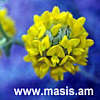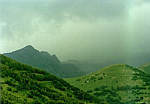Geography /Climate
Weather, Rain, Sunshine
TourArmenia
With eight geographic, seven climates, nine altitudes, sixteen soil zones; as well as over half of all plant species in the Transcaucasus and two-thirds of all bird species found in Europe, Armenia’s small territory is a stunning biotops region.
More varieties of topography and flora can be found per square kilometer in Armenia than anywhere in the Northern Hemisphere. Only the USA rivals Armenia in Flora and bird species, and it encompasses roughly 100 times the territory. The relative ease of exploring these often over-lapping zones makes Natural Armenia a destination of its own.
Types of Terrrain
Armenia’s rich diversity of terrain includes Dry Sub-Tropic, Mediterranean, Desert, Semi-Desert, Mountain Steppes, Mixed Forest, Sub-Alpine and Alpine vegetation zones. These are further subdivided in to 17 specific vegetation zones. There are even a few glaciers thrown in for extra measure in the upper altitudes. The area around Yerevan alone stretches over five vegetation zones, with a mixture of flora and fauna rarely seen elsewhere.
Topography
The terrain was created by millions of years of volcanic and tectonic plate activity which slowly enclosed a vast sea that once covered the entire country up to the Sevan Mountain Range. In its earliest period (380 million years BCE), almost the entire Republic lay under water. Around 170 million years BCE volcanic activity began to from land masses and by 10 million years BCE the Geghama Lehr (Mountain Range) and the mountains making up Southern Armenia were formed. As recently as 500,000 years BCE (by which time Homo Sapiens had been inhabiting the area for at least 500,000 years), at least five volcanoes were still active: Aragats, Azhdahak, Spitakasar, Vardenis and Astghonk.
Climate
Much of this is due to Armenia’s unique weather systems, which mix moisture from heavy snowfalls in the mountains and the Black and Caspian Seas with hot blasts of air from the Syrian and Iranian plateaus. The mixture produces incredibly diverse amounts of rainfall, from a mere 250 mm (10 inches) a year in the lowlands to 550 mm (21 inches) in the mountains. At the same time, ecosystems formed by large forests in Northeastern and Southern Armenia produce their own climates, so that the region around Haghbat and above Kapan can count on 50-60 inches of precipitation annually. Most of the country's precipitation comes from snowfall, which averages 100 cm (40 inches) in the middle mountain regions alone.
Armenia is protected from the harsh winter conditions of the Russian landmass by the Northern Caucasus Mountains, and consequently receives much of its weather from the Persian and Syrian Plains. In wintertime, the Southern regions and northernmost regions are thew warmest. While the mountains may be covered with snow, lower valleys are clear, getting their first spring flowers as early as the end of January. The southernmost area of the country is considered Dry Subtropical: while Giumri is still receiving its last winter snowfall in April, Meghri has begun its second harvest. Ararat Valley is one of the lowest areas in Armenia, and does not receive as much snowfall or rain as the upper elevations.
Weather
The weather changes according to the great variety of geographic terrain. While it may be sunny and hot in the Ararat valley, 60 kilometers away in Sevan it may be cold and rainy, and snowing in the upper regions of Aragats. Common July temperatures range between Ararat Valley highs of 25-30° C (77-86° F) to middle mountain regions summer highs of 18-20° C (64-68° F). The absolute recorded high was 42° C (107.6° F), in Ararat Valley. Common January temperatures range between Ararat Valley lows of -5 to -7° C (23 to 19° F), with an absolute recorded minimum of -30° C (-22° F); to middle mountain regions common lows of -8 to -12° C (16 to 12° F) and an absolute low of -46° C (-46° F) recorded at Arpi. The average number of frost-free days in Armenia is 250 in Ararat Valley, and 150-200 days in the middle mountain areas. In the upper elevations no more than 30-50 days are considered frost-free.
Rainfall
Armenia receives a total average precipitation of 550 mm (21.6 inches). Ararat Valley receives the least amount of precipitation, 200-250 mm (7.9 to 10 inches). The most amount of precipitation occurs in the upper regions, and during Spring and early Summer, with a second rainy season in October and November. When rain falls in the summer months, it often begins with a drizzle and soon develops into a downpour. In the winter months, snow does not last in the Ararat Valley, as the temperatures often vary between freezing and just above. In the middle mountain areas, the snow will keep for long periods of time, and commonly reaches 100 cm (40 inches).
Sunshine
Armenia receives an average of 2700 sun hours of light a year. In the summer months, the Ararat valley is perpendicular to the sun, and each sq. cm of land receives per minute 1.46 calories of heat. Because of the perpendicular alignment of the land with the sun, people who sunbathe can obtain very even suntans (listen up, beach bums).



LINKS
Images (photos
by Tigran Nazarian)
Eco Agrotourism
in South Caucaus (excellent maps)
Ecotourism.com
EcoTeam
Development
Armenian Flora/Fauna Stamps
Weather Forecasts
Climate
Change Info Center-Armenia
ERMC
National Academy of
Sciences of Armenia
Protected
Areas of Armenia
Map
of Sevan National Park
INDIVIDUAL REPORTS
Threatened
Species in Armenia
State
of Environment Report 2000 (UN)

 write TourArmenia
write TourArmenia
 Top
Top

|





